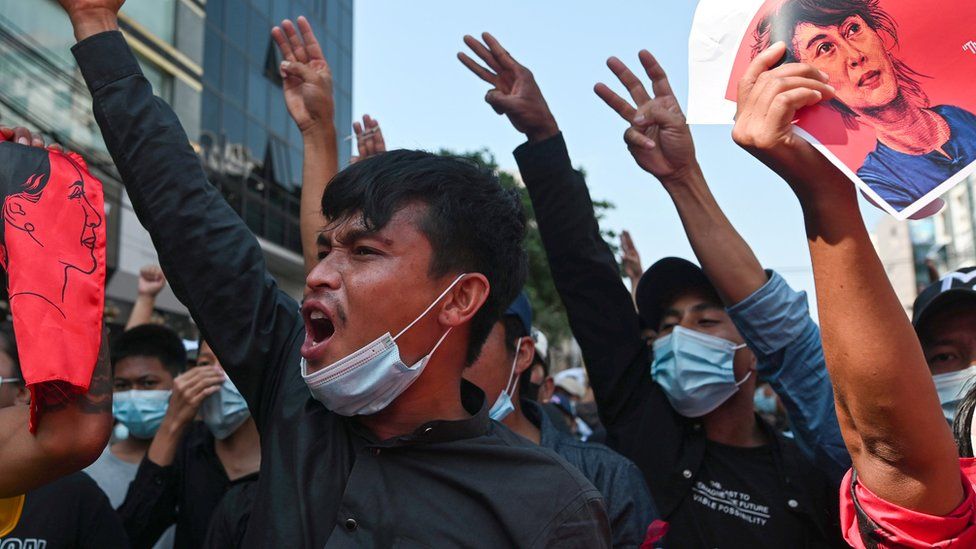It has been exactly two years since the Myanmar army took power.

Myanmar Coup: A quick recap
- A coup in Myanmar began on the morning of 1 February 2021, when democratically elected members of the country’s ruling party, were deposed by the Tatmadaw—Myanmar’s military.
- The coup occurred the day before Myanmar’s Parliament was to swear in the members elected in the 2020 election, preventing this from happening.
- Aung San Suu Kyi, the pivotal leader, was detained, along with ministers, their deputies, and members of Parliament.
India’s policy balancing act in Myanmar
- India has pursued a ‘Dual-Track Policy,’ which essentially means doing business with the junta, for nearly three decades.
- Along four northeastern states, India shares a 1,600-kilometer border with Myanmar.
- It has a maritime boundary in the Bay of Bengal, and its failure presents a foreign policy quandary that it is attempting to resolve.
- Since 1990, it has ruled Myanmar with tea and sympathy for the people for all but five years.
Why is this in the news now?
- Hundreds of armed pro-democracy civilian resistance groups (People’s Defence Forces) are fighting the junta and denying the army access to large swaths of the country.
- Furthermore, some of the two dozen ethnic armed organisations (EAOs) that have been fighting the Myanmar state for autonomy for the last seven decades have allied with the PDFs.
Concerns in India
- Chinese inroads: As China, with its deep pockets, emerged as a rival in the region over the last two decades, engaging with the junta was seen as a way to maintain Indian influence in Myanmar.
- No democratic restoration: During the last decade’s “democratic transition,” Delhi had to calibrate this engagement and rebalance the dual track.
- Even with India’s narrowly defined national interests: border security management and limiting China in Myanmar, these are becoming apparent.
- Limitations of strategy: India has stuck to its old engagement model of doing business with the military regime, encouraging it to restore democracy, and sympathising with democratic forces.
Recent achievement: Sittwe Port has been completed.
- Sittwe port, developed by India as part of the Kaladan project, was ready for operation in the first week of January.
- It will be inaugurated soon.
Five ways India’s calculations have been thrown off
- Bluffing on connectivity: While maritime trade was one goal, the primary goal of this project, which was to provide alternate access to India’s landlocked north-east states, now appears to be a bridge too far.
- Massive influx of refugees: Tens of thousands of refugees from Myanmar’s neighbouring Chin state are being housed in Mizoram. Refugees have entered other Northeastern states, albeit in smaller numbers.
- Terrorist clouds: More dangerously, the recent bombing of a Chin militia headquarters on the border with Mizoram by the Myanmar Air Force, with shrapnel hitting the Indian side during this operation, sparked panic in the area.
- Another potential cross-border spillover is narcotics smuggling, according to the latest UN Office on Drugs and Crime report on Myanmar (Myanmar Opium Survey).
- Supporting Indian insurgents: The Myanmar junta has recruited Indian insurgent groups (IIGs) in Manipur and Nagaland to fight the local PDFs and other groups.
- The Rohingya crisis is worsening: The military is unable to resolve the Rohingya crisis, which is yet another regional destabilizer.
Way forward for India
- In the G20, India has positioned its year-long presidency as an opportunity to project the voice of the global south.
- Extra-diplomatic engagement: India can open channels to democratic forces and ethnic groups; it can work more actively with ASEAN; it can open an army-to-army channel with the junta; it can increase people-to-people channels; and it can offer scholarships to Myanmar students, as it did to Afghan students in a previous era.
- Ensuring fair elections: The junta is considering holding elections later this year after switching from the first-past-the-post system to proportional representation in order to weaken the NLD’s electoral power.
Source: https://indianexpress.com/article/explained/2-years-after-coup-myanmars-mess-and-indias-headache-8422945/
